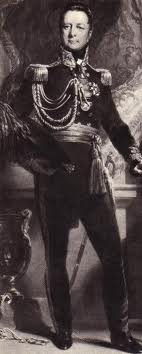Annotation:Earl of Dalhousie's Reel (2)
X:1 T:Earl of Dalhouse's [sic] Reel T:Earl of Dalhousie's Reel [2] M:C L:1/8 R:Reel S:John Rook music manuscript collection (1840, p. 6) N:Rook was a multi-instrumentalist from Waverton, near Wigton, Cumbria Z:AK/Fiddler’s Companion K:D fe|d2 fd AAfd|egfe dBBe|d2 fd Agfe|dBAF D/D/D De| d2 fd AAfd|egfe dBBf|d2 fd ecdB|BdAF D/D/D D:| |:B|ADFA B2 Bd|ABFA BEEB|ADFA BcdA|BdAF D/D/D DB| ADFA B2 Bd|AdFA BEEB|AFFA Bcde|fdAF D/D/D D2:|]
EARL OF DALHOUSIE('S REEL) [2], THE. AKA and see "Earl of Dalkeith's Reel (3)," "Lady Johnston's Reel," "Lord Dalhousie," "Maid of Holywell (The)." Scottish, Reel. E Flat Major (Athole, Gow, Johnson): D Major (Kerr). Standard tuning (fiddle). AB (Athole): AA'BB' (Johnson, Kerr). Composed by Biography:Nathaniel Gow (1763-1831) just prior to 1800, in honor of George Ramsay (1770-1838), the 9th Earl of Dalhousie. Dalhousie was a soldier who fought with distinction in the Napoleonic Wars, eventually commanding the British 7th Division in the Peninsular Campaign under Lord Wellington. Dalhouse was in the Pyrenees with his division in 1813, but returned to England in October of that year (see "The Earl of Dalhousie's Welcome from the Pyrenees") for a short time before returning to his division. Later her was Lt. Governor of Nova Scotia (where he created Dalhousie University in Halifax), then Governor General of Canada from 1819-1828. In 1815 he was created Baron Ramsay. In 1816 the Baron observed in writing that the populace of Canada were very poor, very indolent, fond of rum and that they generally appear half-drunk. They waste time loitering about their houses and their field work, he complained, and seem content in raising a sufficiency of potatoes for their winter. Despite his insensitivity toward the population he governed, the Earl was a staunch supporter of Scottish music, and of Gow in particular. At the Earl's ball in 1811, for which Nathaniel and his band provided the music, Dalhousie presented him with a massive silver goblet, accompanied with a note that read:--An old friend of Gow's requests his acceptance of a cup, in which to drink the health of the thousands who would wish, but cannot attend him to-night. Dalhousie subsequently became Commander in Chief in India before his final return to Dalhousie Castle, Midlothian. See also Annotation:Lord Dalhousie.

James Stewart-Robertson (1884) notes that E Flat Major was the original key for the tune. Pieces in the keys with more flats were a challenge to the common Scots fiddler, and Gow's use of them in his compositions shows a developing classical influence that assumed the more difficult fingerings (Johnson, 1984). Multi-instrumentalist John Rook, of Waverton, near Wigton, Cumbria, entered "Earl of Dalhousie [2]" into his large music manuscript collection in 1840, set in the key of 'D'.
d

